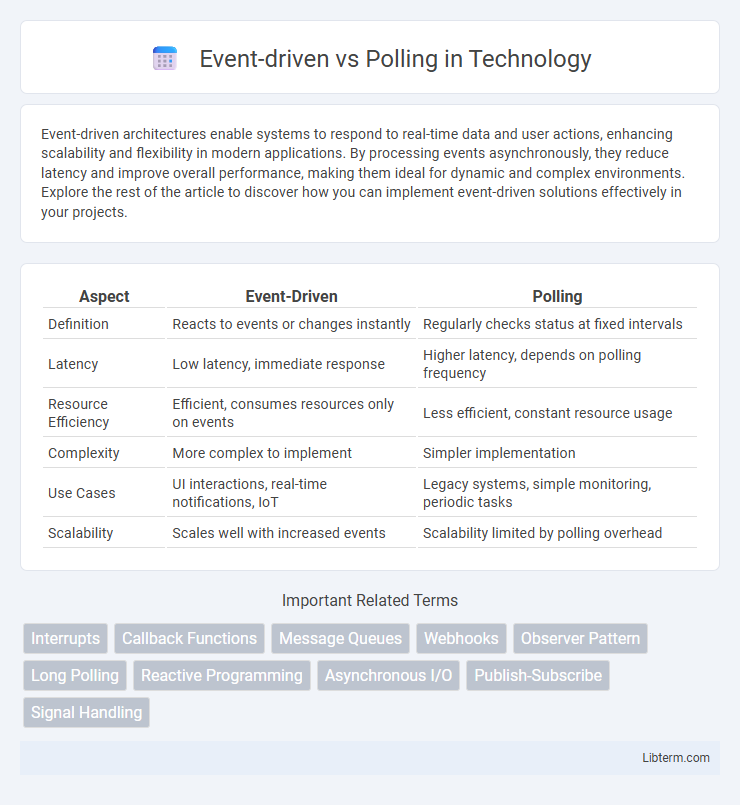Event-driven architectures enable systems to respond to real-time data and user actions, enhancing scalability and flexibility in modern applications. By processing events asynchronously, they reduce latency and improve overall performance, making them ideal for dynamic and complex environments. Explore the rest of the article to discover how you can implement event-driven solutions effectively in your projects.
Table of Comparison
| Aspect | Event-Driven | Polling |
|---|---|---|
| Definition | Reacts to events or changes instantly | Regularly checks status at fixed intervals |
| Latency | Low latency, immediate response | Higher latency, depends on polling frequency |
| Resource Efficiency | Efficient, consumes resources only on events | Less efficient, constant resource usage |
| Complexity | More complex to implement | Simpler implementation |
| Use Cases | UI interactions, real-time notifications, IoT | Legacy systems, simple monitoring, periodic tasks |
| Scalability | Scales well with increased events | Scalability limited by polling overhead |
Introduction to Event-driven and Polling Models
Event-driven models rely on system-generated events to trigger specific actions, reducing CPU usage by responding only when necessary. Polling models continuously check the status of a resource or condition at regular intervals, which can lead to higher latency and inefficiency. Understanding the trade-offs between event-driven responsiveness and polling persistence is crucial for optimizing application performance and resource management.
Defining Event-driven Architecture
Event-driven architecture (EDA) is a software design paradigm where system components communicate by producing and consuming events asynchronously, enabling real-time responsiveness and scalability. Unlike polling, which continuously checks for updates, EDA relies on event emitters to notify subscribers only when relevant changes occur, reducing resource consumption and latency. This architecture is widely used in microservices, IoT, and distributed systems for efficient data flow and decoupled system components.
Understanding Polling Mechanisms
Polling mechanisms involve continuously checking the status of a device or resource at regular intervals to detect changes or events, resulting in a straightforward yet potentially resource-intensive process. This technique relies on the CPU to repeatedly query the target, which can introduce latency and inefficiency, especially in high-demand or real-time environments. Effective polling optimization requires balancing the polling frequency to minimize resource usage while maintaining timely responsiveness.
Key Differences Between Event-driven and Polling
Event-driven systems respond to specific events or changes in state, triggering actions immediately when conditions are met, while polling systems repeatedly check for changes at regular intervals regardless of state changes. Event-driven architecture enhances efficiency by reducing latency and resource consumption, whereas polling can cause higher CPU usage and delayed response times due to constant checking. Key differences include responsiveness, system resource utilization, and scalability, with event-driven models generally preferred for real-time applications and polling used in simpler or legacy systems.
Advantages of Event-driven Systems
Event-driven systems offer higher efficiency by processing data only when events occur, reducing CPU usage compared to continuous polling. These systems improve responsiveness and scalability, enabling real-time handling of user actions and sensor inputs. Event-driven architectures also simplify resource management and lower latency in applications such as IoT devices and interactive user interfaces.
Benefits and Limitations of Polling
Polling provides a straightforward method for checking the status of devices or events at regular intervals, enabling simple implementation without complex event-handling mechanisms. Its limitations include increased CPU usage and potential latency, as the system may waste resources repeatedly checking for events that have not occurred, leading to inefficiency in real-time applications. Polling can struggle with scalability and responsiveness, especially when monitoring numerous inputs or when timely event detection is critical.
Use Cases: When to Choose Event-driven
Event-driven architecture excels in real-time applications such as IoT sensor networks, financial trading platforms, and user interface responsiveness where immediate reaction to changes is critical. This approach reduces resource consumption by eliminating constant status checks, making it ideal for scalable cloud services and microservices communication. Event-driven models enhance system efficiency in environments requiring asynchronous processing and low-latency data handling.
Use Cases: When Polling is Preferable
Polling is preferable in scenarios requiring regular status checks where event support is unavailable, such as legacy systems or simple hardware interfaces. It suits use cases demanding predictable intervals for data retrieval, like periodic sensor readings or batch job monitoring. Environments with low event generation frequency benefit from polling to avoid overhead from event management.
Performance and Resource Consumption Comparison
Event-driven architecture significantly reduces CPU usage and latency by responding immediately to events, eliminating the constant checks characteristic of polling systems. Polling frequently consumes more resources as it repeatedly queries the system state, leading to unnecessary power consumption and slower response times. High-performance applications benefit from event-driven models due to their efficient resource utilization and faster data processing capabilities.
Future Trends in Event-driven and Polling Approaches
Future trends in event-driven architectures emphasize increased adoption of real-time data processing with the integration of AI and machine learning for predictive event handling. Polling techniques are evolving with adaptive intervals and edge computing to reduce latency and network load. Hybrid models combining event-driven responsiveness and intelligent polling offer scalable solutions for IoT and distributed systems.
Event-driven Infographic

 libterm.com
libterm.com